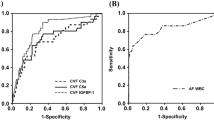Abstract
Objective
To test the hypothesis that the color of meconial fluid is associated with inflammatory biomarkers, by determining C-reactive protein (CRP) and Interleukin-6 (IL-6) in serum from the umbilical cord.
Methods
In this prospective study, the authors selected 30 newborns with meconium-stained amniotic fluid (MSAF): 14 with green/brown 656 R color and 16 with brown/cinnamon 654 R color, and 20 newborns which showed clear amniotic fluid without MSAF (non-MSAF); all newborns were from mothers without risk factors for neonatal sepsis.
Results
IL-6 concentration from umbilical cord blood, [median of 12.9 pg/mL (interquartile range {IQR} 8.7–31.0)] of MSAF-green/brown 656 R increased significantly (p < 0.05) when compared with IL-6 concentration, [median of 9.2 pg/mL (IQR 7.2–12.2)] of newborns with clear amniotic fluid and without meconium. CRP from MSAF-green/brown 656 R was median of 0.5 mg/mL (IQR 0.0–2.7), and median of 1.0 mg/mL (IQR 0.0–5.5) from clear amniotic fluid, without meconium.
Conclusions
Significant association was found between MSAF-green/brown 656 R and increase in IL-6, with normal CRP values.

Similar content being viewed by others
References
Kimble RM, Trudenger B, Cass D. Fetal defaecation: is it a normal physiological process? J Paediatr Child Health. 1999;35:116–19.
Scott H, Walker M, Gruslin A. Significance of meconium-stained amniotic fluid in the preterm population. J Perinatol. 2001;21:174–7.
Parida SN, Verma IC, Thomas S, Sachdev HPS. Meconium staining of amniotic fluid and its association with fetal distress and gestational age. Indian J Pediatr. 1980;47:141–3.
David AN, Njokanma OF, Iroha E. Incidence of and factors associated with meconium staining of the amniotic fluid in a Nigerian University Teaching Hospital. J Obstet Gynaecol. 2006;26:518–20.
Hess LW, Anderson RL, Golbus MS. Significance of opaque discolored amniotic fluid at second-trimester amniocentesis. Obstet Gynecol. 1986;67:44–6.
Isada NB, Koppitch 3rd FC, Johnson MP, Evans MI. Does the color of amniotic fluid still matter? Fetal Diagn Ther. 1990;5:165–7.
Steinborn A, Günes H, Röddiger S, Halberstadt E. Elevated placental cytokine release, a process associated with preterm labor in the absence of intrauterine infection. Obstet Gynecol. 1996;88:534–9.
de Beaufort AJ, Bakker AC, van Tol MJ, Poorthuis BJ, Schrama AJ, Berger HM. Meconium is a source of pro-inflammatory substances and can induce cytokine production in cultured A549 epithelial cells. Pediatr Res. 2003;54:491–5.
Glynn EF. Color Chart. Stowers Institute for Medical Research. Mushegian Lab Bioinformatic Center 2008. [Updated 31 Oct 2008; cited 24 May 2005]. Available from: http://research.stowers-institute.org/efg/R/Color/Chart/ [Assessed 18th February, 2011].
Hsieh TT, Hsieh CC, Hung TH, Chiang CH, Yang FP, Pao CC. Differential expression of interleukin-1 beta and interleukin-6 in human fetal serum and meconium-stained amniotic fluid. J Reprod Immunol. 1998;37:155–61.
Liu Y, Li P, Lu J, et al. Bilirubin possesses powerful immunomodulatory activity and suppresses experimental autoimmune encephalomyelitis. J Immunol. 2008;181:1887–97.
Tasci Y, Dilbaz B, Uzmez Onal B, Caliskan E, Dilbaz S, Doganci L, et al. The value of cord blood interleukin-6 levels for predicting chorioamnionitis, funisitis and neonatal infection in term premature rupture of membranes. Eur J Obstet Gynecol Reprod Biol. 2006;128:34–9.
Cicco NA, Lindemann A, Content J, et al. Inducible production of interleukin-6 by human polymorphonuclear neutrophils: role of granulocyte-macrophage colony-stimulating factor and tumor necrosis factor-alpha. Blood. 1990;75:2049–52.
Suwa T, Hogg JC, Klut ME, Hards J, van Eeden SF. Interleukin-6 changes deformability of neutrophils and induces their sequestration in the lung. Am J Respir Crit Care Med. 2001;163:970–6.
Suwa T, Hogg JC, English D, Van Eeden SF. Interleukin-6 induces demargination of intravascular neutrophils and shortens their transit in marrow. Am J Physiol Heart Circ Physiol. 2000;279:H2954–60.
Marchini G, Hagenäs L, Kocoska-Maras L, Berggren V, Hansson LO. Insulin-like growth factor binding protein-1 and interleukin-6 are markers of fetal stress during parturition at term gestation. J Pediatr Endocrinol Metab. 2005;18:777–83.
Majello B, Arcone R, Toniatti C, Ciliberto G. Constitutive and IL-6-induced nuclear factors that interact with the human C-reactive protein promoter. EMBO J. 1990;9:457–65.
Ganapathi MK, Rzewnicki D, Samols D, Jiang SL, Kushner I. Effect of combinations of cytokines and hormones on synthesis of serum amyloid A and C-reactive protein in Hep 3B cells. J Immunol. 1991;147:1261–5.
Acknowledgements
The authors want to extend special thanks to Jan Moreno for her editorial assistance.
Contributions
All authors participated in planning the study. RSB and GMA designed the study and recruited the patients. EZ, PH, RMC, and MCM co-designed the study and analyzed data. APP, RZA, and YRA co-designed the study and reviewed the manuscript. LPCM, SAR, MLB, and EPC co-designed the study and prepared the manuscript. LPCM and EPC wrote the final manuscript.
Conflict of Interest
None.
Role of Funding Source
None.
Author information
Authors and Affiliations
Corresponding author
Rights and permissions
About this article
Cite this article
Silva-Bravo, R., Mayoral-Andrade, G., Zenteno, E. et al. Color of Meconium and Interleukin-6. Indian J Pediatr 79, 48–51 (2012). https://doi.org/10.1007/s12098-011-0447-4
Received:
Accepted:
Published:
Issue Date:
DOI: https://doi.org/10.1007/s12098-011-0447-4




